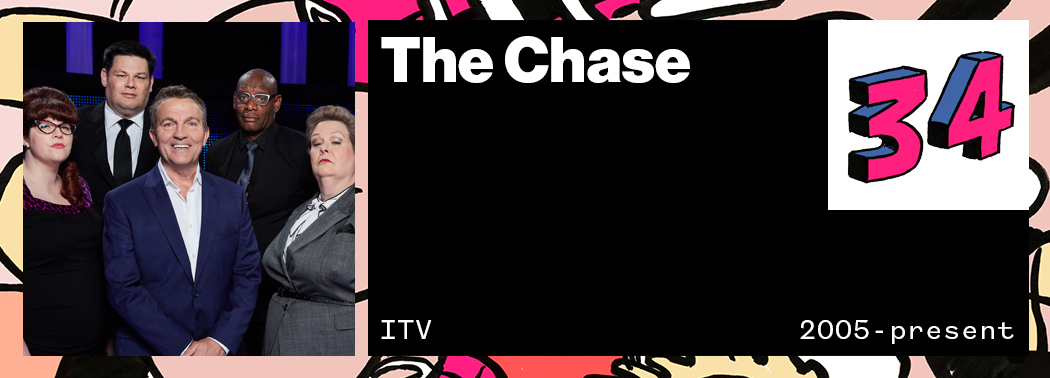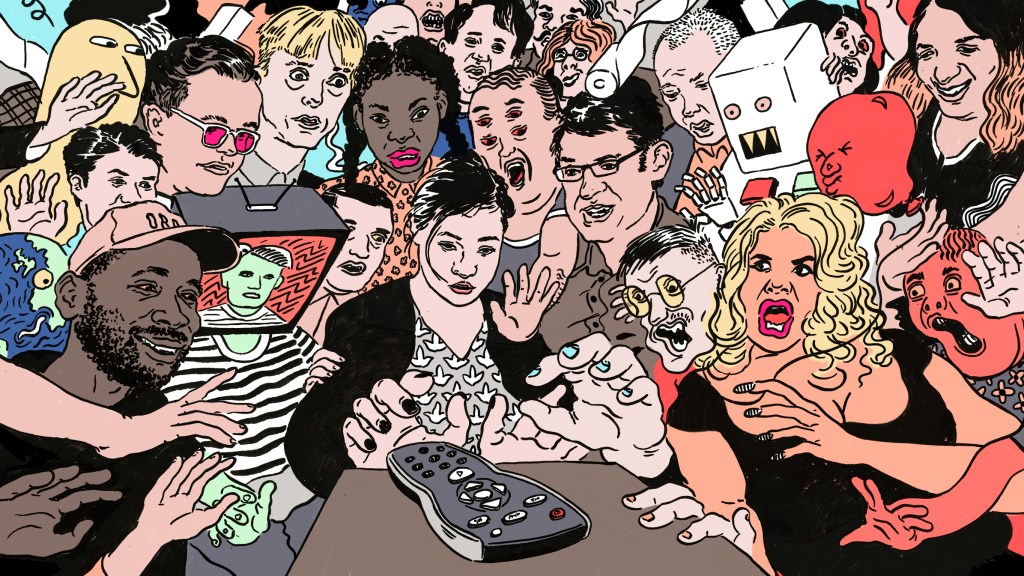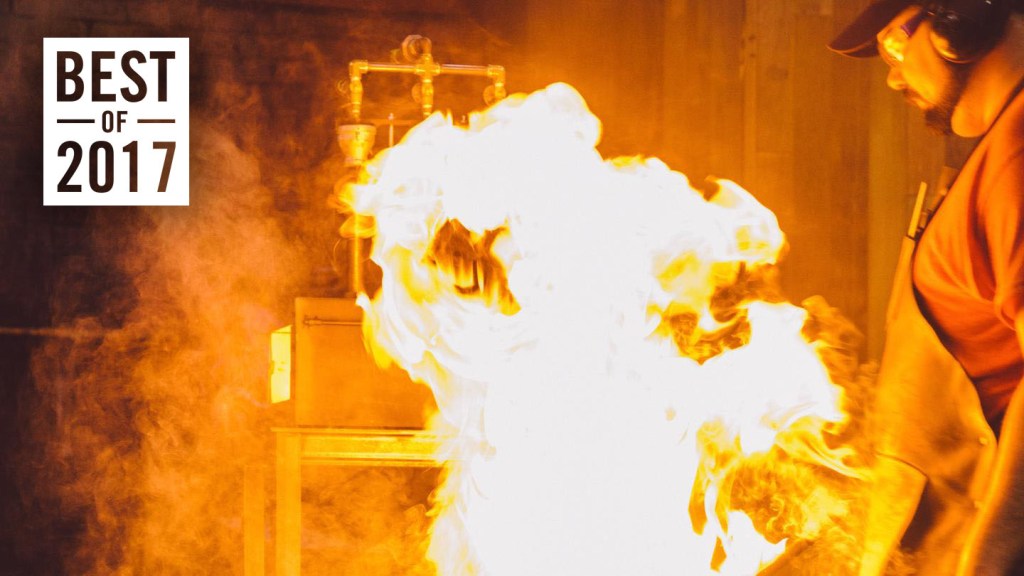Welcome. You’re hitting the top 30 of VICE’s first ever attempt to grade and categorise the greatest British television since the millennium. Think of it as a TV version of our Love Island Power Ranking, except with more Rob Brydon and fewer I Saw It First bikini thongs.
This group of shows has everything: Nick Cave’s son, Frodo; interactive grime drama; bizarre phone pranks; moving depictions of addiction and family abuse; and the most accurate parody of VICE committed to celluloid. Oh, and Richard Ayoade. What more could you ask for?
Videos by VICE
Read our editor’s letter here to find out how we decided what ranked where, and click here to read all of the articles from this series.
50-41: Here we go…

40. ‘Marion & Geoff’ (2000 – 2003, BBC Two)
With one actor, one camera and one car, Marion & Geoff guides us through the breakdown of a marriage with more depth and nuance than some HBO dramas. Starring Rob Brydon as Keith Barret, a taxi driver whose wife (Marion) left him for her colleague (Geoff), the show is essentially a divorce vlog – with Keith monologuing into a camera on the dashboard of his car. As he drives around, Keith chats away like a friendly lone-drinker who corners you at the pub, unwittingly revealing the sadness of his life while insisting he’s “the happiest he’s ever been!” On his birthday, he cheerily announces that he’s been “inundated with mail”, which turns out to be: a bill from the phone company and nothing from his two sons, “as yet”.
His optimism is so blinding that Keith doesn’t realise Marion and Geoff were having an affair until he’s mid-way through a story about a birthday pool party at his house, six episodes into series one. When he reaches the part where Geoff’s dad walks into a bedroom and catches them hooking up, Keith obfuscates the details with a long pause… then snaps back into his flow and calls himself an “absolute fool!” for leaving the pool unattended.
Making full use of cut scenes and locations that keep an otherwise static format on its feet, Marion & Geoff is carried on the shoulders of Rob Brydon, whose ease on camera transforms a tragic but ultimately likeable character study into a compelling portrait of loneliness. — Emma Garland

39. ‘The End of the F***ing World’ (2017 – present, Channel 4 and Netflix)
“I’ve seen you skating, you’re pretty shit.”
“Fuck off.”
Thus marks the start of a relationship between two misfit English teenagers that turns into a darkly funny Bonnie and Clyde-style road trip where each of the eight episodes lasts just 20 fucking minutes. Based on an American graphic novel by Charles Forsman and featuring an original score by Graham Coxon, The End of the F***ing World is a love story that manages to be well-written, touching and a little bit gory in a universe where all adults are either idiots or arseholes.
The show’s magic ingredient is Jessica Barden, who is frankly amazing as the deadpan Alyssa. Alec Lawther is brilliant as the gawky wannabe murderer James, too. One great fact: Nick Cave’s son plays a guy called Frodo. Another great fact: They are now filming season two. — Max Daly

38. ‘Dubplate Drama’ (2005 – 2009, Channel 4)
Dubplate Drama arrived during grime’s first wave, and gave late-night viewers an insight into the genre’s inner workings and often-stark realities of street life (featuring rapper Shystie as fledgling MC Dionne, and cameos from the likes of Skepta, Ms Dynamite, Ghetts and N-Dubz). Until that time, underground black music thrived on pirate radio, at parties and raves, on Channel U (RIP) and, of course, on the London council estates where its foundations were laid.
Some critics dismissed Dubplate Drama as a show rooted in “crime and grime”, but it was much more than that – plot lines about toxic relationships, mental health and teen pregnancy sparked conversation among its youth audience. The series examined the nuances around issues that seem to disproportionately affect Britain’s black community, such as a lack of female agency and barriers to access.
Dubplate Drama is also less well-known for being credited as the “world’s first interactive drama”. At the end of each episode, narrator Rodney P gave viewers the chance to steer the narrative by deciding a dilemma through text and phone votes. Those who missed the show on TV could watch it via their Sony PSPs. Ten years on from its finale, it’s not a reach to overstate Dubplate Drama‘s influence – not least because it did audience engagement some 14 years before Black Mirror snatched up all those accolades for the choose-your-own-adventure special Bandersnatch. — David Woode

37. ‘The Mighty Boosh’ (2004 – 2007, BBC Three)
There is nothing I loved more in 2006 than pairing a purple H&M hoodie with some crap leggings, smashing “play” on an Ed Banger compilation and going to Fopp to purchase a DVD box set of The Mighty Boosh. In accordance with popular opinion at the time, I thought electro house was the best genre ever invented, and that an intersex merman loosely based on Rick James interrogating people about drinking Baileys from a shoe was the height of comedy.
Originally a stage show and then a radio series, The Mighty Boosh injected a dose of mischief into the classic odd couple format – Noel Fielding as whimsical metrosexual Vince Noir, Julian Barratt as cynical jazz enthusiast Howard Moon. Their bread and butter was improvisational banter: Noir’s new age optimism vs Moon’s grizzled pseudo-intellectualism. But it was the world they constructed – one where the moon is sentient and Bryan Ferry lives in a house made of bus tickets in the woods – that gave it such a distinctive style. — Emma Garland
Read about how ‘The Mighty Boosh’ went from cool to uncool here.

36. ‘My Mad Fat Diary’ (2013 – 2015, E4)
My Mad Fat Diary is timeless not just because it’s a teen dramedy set in every millennial’s favourite era (the 1990s), but because of the subject matter. Leading the fat revolution in 2013 with an adaptation of Rae Earl’s book of the same name, My Mad Fat Diary did plus-size representation in a way that hasn’t been matched on British TV since.
In the first episode, Rae Earl introduces herself as “16 years old, 16 stone and certified mad”, immediately centring the show on fat mental health. Over two years, we watch as Rae tries to navigate the world not just a teenager, but as a mad, fat one. For those of us who had ever been fat, lonely and mentally unwell, it was the first time we were ever seeing ourselves properly portrayed on TV.
In a world in which many thought they could never be described as mentally unwell due to their size, and after Skins had dominated the previous decade with depictions of teen mental health as mysterious traits of our thin peers, My Mad Fat Diary offered a more down to earth narrative about the joys of finding popularity – and the pitfalls of trying to fit in – in a world that isn’t fat-sized. – Georgina Jones
Read how ‘My Mad Fat Diary’ impacted its teenage plus-size viewers here.

35. ‘Nathan Barley’ (2005, Channel 4)
A scripted horseman of the new media apocalypse to come, Nathan Barley was both a scathing caricature of online journalism at the time and a foreshadowing of its inevitable demise into clickbait. Written by Chris Morris and Charlie Brooker, the show follows Dan (Julian Barratt) – a self-loathing hack who writes an op-ed about “the rise of the idiots”, and is instantly venerated by the staff of Sugar Ape magazine (inspired by VICE and Dazed & Confused) and its audience of fixie bike wankers who fail to realise it’s about them. Portraying a newsroom that prioritises contrarians over trained journalists and pissing people off over reasoned analysis, the show now feels like a fucking massive “told you so” as far as the news cycle is concerned.
In retrospect, some aspects are definitely confined to a pre-woke digital landscape, like when Dan suggests that changing the logo design to “RAPE” with the “Suga” inside the R might be offensive, to which his editor responds: “Stupid people think it’s cool, smart people think it’s a joke – also cool.” But the overall lesson seems to rest in what happens after the gatekeepers of “worthy” subjects and those who got to cover them are pulled down. Since it came so long before Twitter, however, it wasn’t quite able to predict the true future. If that much-deliberated second series of Nathan Barley were to happen now, Dan’s need for money would probably land him writing morally dubious blogs about pop stars for £75 a pop. — Emma Garland

34. ‘The Chase’ (2009 – present, ITV)
No point pretending: I didn’t watch The Chase this time last year. And yet now here I am, delighted to lean in a bit too close and exalt its magnitude. Its premise is simple, asking whether your team of four can survive a multi-round trivia quiz against a “chaser” (i.e. the video game boss to beat) to walk away with a few thousand quid each.
All five chasers – Anne Hegerty, Mark Labbett, Shaun Wallace, Paul Sinha and Jenny Ryan, though of course you probably just use their nicknames – engage in gentle ribbing with host Bradley Walsh. They relish the sort of perambulatory smack-talk patter with their opponents, delivered so firmly in character that their act ascends from “a wrestler warming up” to high camp.
There have been game shows before it, and quiz shows, too. After all, a couple of the chasers appeared on Eggheads, Mastermind and The Weakest Link before landing what, for Labbett (alright, The Beast) and Wallace – AKA The Dark Destroyer – have become decade-long gigs. This show airs every weeknight at prime time. Turn your TV over to Challenge at basically any time of day; chances are you’ll land on it. Even if it were taken off the air today, we’d have enough re-runs to sustain us for years. Just as well – I’ve got a fair bit of catching up to do. — Tshepo Mokoena

33. ‘Fonejacker’ (2006 – 2008, E4)
He’s most recently been seen portraying an inept vampire on HBO’s What We Do in the Shadows, but to a generation of Brits, Kayvan Novak will always be the Fonejacker. Across two series, the comic introduced us to a bevvy of weirdo characters, among them Mr Doovdé – who couldn’t quite grasp the concept of acronyms, hence thinking DVD, PSP and USB were pronounced as words – audacious scammer George Agdgdgwngo (“The computer says that British Gas have overcharged you 36 million Ugandan dollars”) and Cockney wheeler-dealer Terry “Talk To Me” Tibbs.
Fonejacker is one of those bizarre shows that would almost certainly not get made today (follow-up Facejacker, in fact, came complete with unfunny and awful blackface). However, as prank shows go, those first two brilliant series were really up there, proving that British TV pranks don’t have to be limited to Ant and Dec in silly wigs. — Hannah J Davies

32. ‘Patrick Melrose’ (2018, Sky)
We’re pushing it somewhat with this show, since it was produced by Anglo-American company Little Island. But it won two BAFTAs, OK? It counts. Anyway, Patrick Melrose devastatingly tells a story of addiction and family and grief without falling into any of the cliche pitfalls you might imagine from that short list of themes.
Benjamin Cumberbatch’s titular Patrick, pulled taut to snapping point by a taste for heroin, careens between processing his father’s death, being bombarded by flashbacks that show you the person his father really was and trying to crawl out from the sticky quicksand of a dependence on booze, class As and, when the mood strikes, quaaludes.
We’ve seen so many “white guy has substance use problems” content over the past century, but this five-episode series sets itself apart with the sort of visceral cinematography and acting that may make you involuntarily gag one moment, then sob the next. Please send complaints about this not really being British to letters@vice.com. — Tshepo Mokoena

31. ‘Travel Man’ (2015 – present, Channel 4)
The person who went into the Channel 4 travel show pitch meeting with the single sentence, “Exceedingly charming man Richard Ayoade is joined by an equally charming comedy guest for 48 hours in a new city” really got it in one.
Since 2015, Travel Man has livened up UK travel programming, as Ayoade – a warm, funny host – explores cities in a way that reflects how we travel now. The attractions the show parses strike a balance between well-known and downright bizarre (a recent visit to, erm, the Museum of Additives in Hamburg?? Featuring Bob Mortimer?? For example??), making it a genuinely helpful tool for travel and a beautiful thing to hit play on when you’re either hungover or broke – or both. — Lauren O’Neill
30-21: Things are heating up.
20-11: Time to get serious.
10-1: The Champions League.
Click here to read all of the articles from this series.



